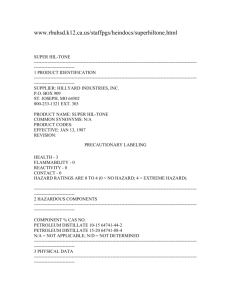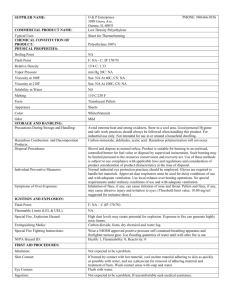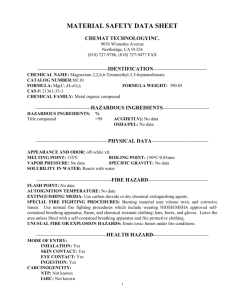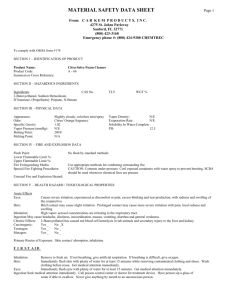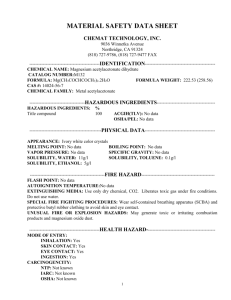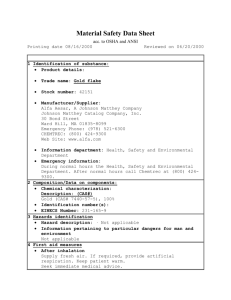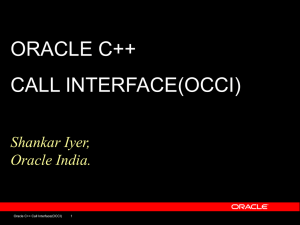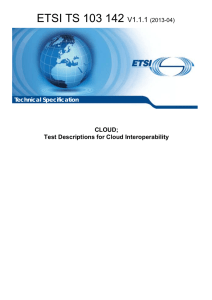MATERIAL SAFETY DATA SHEET
advertisement
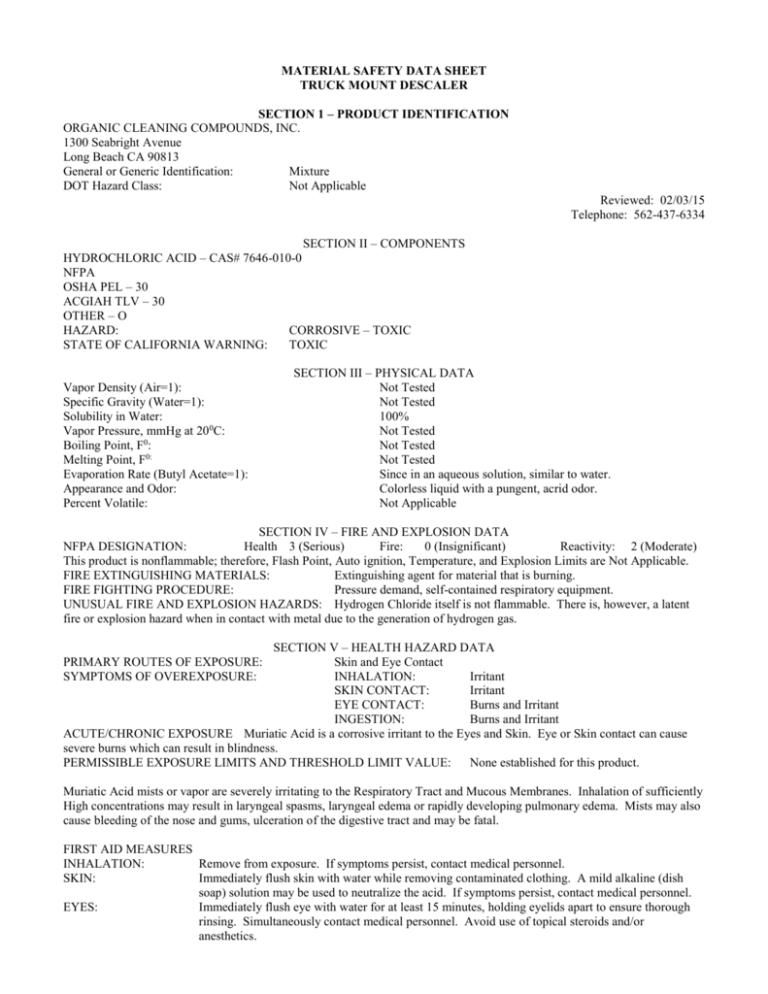
MATERIAL SAFETY DATA SHEET TRUCK MOUNT DESCALER SECTION 1 – PRODUCT IDENTIFICATION ORGANIC CLEANING COMPOUNDS, INC. 1300 Seabright Avenue Long Beach CA 90813 General or Generic Identification: Mixture DOT Hazard Class: Not Applicable Reviewed: 02/03/15 Telephone: 562-437-6334 SECTION II – COMPONENTS HYDROCHLORIC ACID – CAS# 7646-010-0 NFPA OSHA PEL – 30 ACGIAH TLV – 30 OTHER – O HAZARD: CORROSIVE – TOXIC STATE OF CALIFORNIA WARNING: TOXIC Vapor Density (Air=1): Specific Gravity (Water=1): Solubility in Water: Vapor Pressure, mmHg at 200C: Boiling Point, F0: Melting Point, F0: Evaporation Rate (Butyl Acetate=1): Appearance and Odor: Percent Volatile: SECTION III – PHYSICAL DATA Not Tested Not Tested 100% Not Tested Not Tested Not Tested Since in an aqueous solution, similar to water. Colorless liquid with a pungent, acrid odor. Not Applicable SECTION IV – FIRE AND EXPLOSION DATA NFPA DESIGNATION: Health 3 (Serious) Fire: 0 (Insignificant) Reactivity: 2 (Moderate) This product is nonflammable; therefore, Flash Point, Auto ignition, Temperature, and Explosion Limits are Not Applicable. FIRE EXTINGUISHING MATERIALS: Extinguishing agent for material that is burning. FIRE FIGHTING PROCEDURE: Pressure demand, self-contained respiratory equipment. UNUSUAL FIRE AND EXPLOSION HAZARDS: Hydrogen Chloride itself is not flammable. There is, however, a latent fire or explosion hazard when in contact with metal due to the generation of hydrogen gas. SECTION V – HEALTH HAZARD DATA Skin and Eye Contact INHALATION: Irritant SKIN CONTACT: Irritant EYE CONTACT: Burns and Irritant INGESTION: Burns and Irritant ACUTE/CHRONIC EXPOSURE Muriatic Acid is a corrosive irritant to the Eyes and Skin. Eye or Skin contact can cause severe burns which can result in blindness. PERMISSIBLE EXPOSURE LIMITS AND THRESHOLD LIMIT VALUE: None established for this product. PRIMARY ROUTES OF EXPOSURE: SYMPTOMS OF OVEREXPOSURE: Muriatic Acid mists or vapor are severely irritating to the Respiratory Tract and Mucous Membranes. Inhalation of sufficiently High concentrations may result in laryngeal spasms, laryngeal edema or rapidly developing pulmonary edema. Mists may also cause bleeding of the nose and gums, ulceration of the digestive tract and may be fatal. FIRST AID MEASURES INHALATION: Remove from exposure. If symptoms persist, contact medical personnel. SKIN: Immediately flush skin with water while removing contaminated clothing. A mild alkaline (dish soap) solution may be used to neutralize the acid. If symptoms persist, contact medical personnel. EYES: Immediately flush eye with water for at least 15 minutes, holding eyelids apart to ensure thorough rinsing. Simultaneously contact medical personnel. Avoid use of topical steroids and/or anesthetics. INGESTION: Give a quart of milk/water to drink. DO NOT INDUCE VOMITING. Take immediately to hospital. Avoid use of carbonates and bicarbonates as they release C 02 which may cause gastric tension and/or rupture. Neutralization of the acid may be accomplished by using milk of magnesia. Avoid use of aspirin. Subsequent treatment should be symptomatic and supportive. TOXICITY DATA: CARCINOGENICITY: This material is not considered to be a carcinogen by the National Toxicology Program, the International Agency for research on Cancer or the Occupational Safety and Health Administration. CALIFORNIA WARNING: Hydrochloric Acid is classified as containing suspected reproductive toxins (lead). STABILITY: POLYMERIZATION: CONDITIONS TO AVOID: MATERIALS TO AVOID: HAZARDOUS DECOMPOSITION: SECTION VI – REACTIVITY DATA Stable. Will not occur Heat, Open Flame Metals, Strong Alkali Hydrogen forms if acid come into contact with metals. SECTION VII – SPILL, LEAK AND DISPOSAL PROCEDURES Comply with all applicable governmental regulations on spill reporting, handling and disposal of waste. SPILL AND WASTE DISPOSAL PROCEDURES: Small quantities may be flushed to sewer with copious amounts of water. Large spills should be neutralized cautiously with soda ash, then flushed with copious amounts of water. SECTION VIII – PROTECTIVE EQUIPMENT TO BE USED Suitable protective clothing, gloves and footwear should be selected with regard for use, conditions and exposure potential. Have access to water. Follow good industrial hygiene and safety practices as with any industrial chemical. EYE PROTECTION: Chemical goggles good practice if splashing conditions exist. GLOVES: Impervious gloves recommended if contact is prolonged. VENTILATION: No special precautions under normal use. Local exhaust capable of minimizing dust/vapor/mist emissions at point of use below lowest TLV/PEL. RESPIRATORY: If use conditions generate dust/vapors/mists, wear a NIOSH approved respirator appropriate for those emission levels. OTHER CLOTHING AND EQUIPMENT: None likely to be needed. SECTION IX – SPECIAL PRECAUTIONS OR OTHER COMMENTS STORAGE AND HANDLING PRECAUTIONS: Store in cool, dry area away from metals. Keep container closed when not in use. Wash thoroughly after handling. NOTICE Organic Cleaning Compounds, Inc. (OCCI) expressly disclaims all express or implied warranties of merchantability and fitness for a particular purpose, with respect to the product or information provided herein. All information appearing herein is based upon data obtained from the manufacturer and/or recognized technical sources. While the information is believed to be accurate, OCCI make no representations as to its accuracy or sufficiency. Conditions of use are beyond OCCI’s control and therefore, users are responsible to verify this data under their own operating conditions to determine whether the product is suitable for their particular purposes. Users assume all risks of the use, handling and disposal of the product. Users assume all risks dependent upon the publication or use of, or reliance upon information contained herein. This information relates only to the product designated herein, and does not relate to its use in combination with any other material or in any other process.
